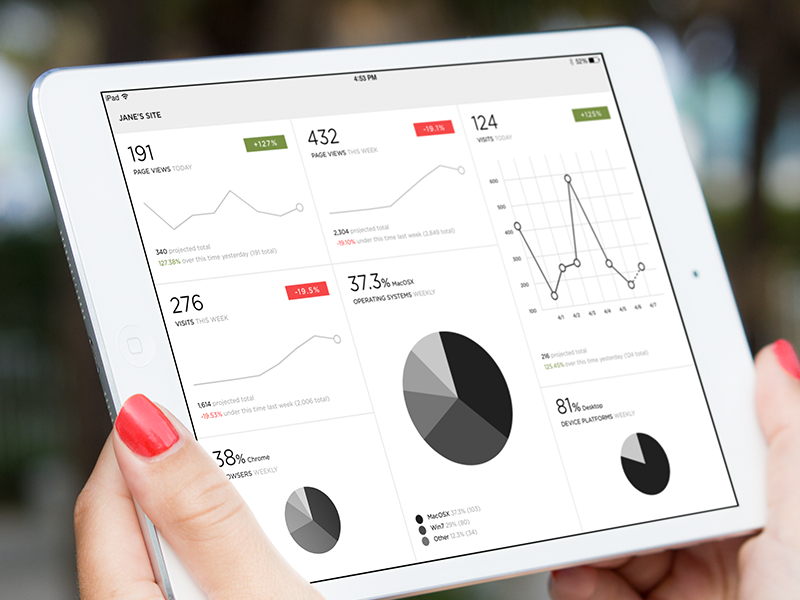When you balance your checkbook, you immediately look at your account balance.
When you’re about to buy a home or a car, you pull your credit score.
When you’re talking about the big game with friends, you reference things like rushing yards and pass completions.
All of these numbers give you an immediate read on the situation at hand, good or bad, and all of them can be considered KPIs. KPIs are Key Performance Indicators that help you and your colleagues gauge the health of your business at a glance, and when used correctly, they can be highly effective for driving growth.
KPI Basics

Simply put, a KPI is any measurable factor that has an impact on your business’ bottom line. There are as many different KPIs as there are fish in the sea, but the key is choosing only the ones that matter most in your ecosystem.
Here’s a shortlist of some of the most common KPIs:
Total sales
Total transactions
Revenue growth rate
New customers vs. returning customers
Customer retention rate
Customer satisfaction rating
Cash on hand
Labor cost to revenue ratio
Inventory turnover ratio
Wait time
Customer acquisition cost
Customer lifetime value
Number of support tickets
Employee turnover rate
These examples are just a drop in the proverbial KPI bucket. Business speaker and performance specialist Bernard Marr has a list of 75 KPIs that may help you identify and select the ones that stand out most for your brand.
But don’t get carried away—we can’t emphasize enough the importance of choosing just 3-5 KPIs to focus on. Otherwise, your efforts will be spread too thin to make a noticeable impact (and your employees’ heads will likely be spinning from so many numbers!).
KPIs and The Team

Aside from helping you take your company’s pulse at a moment’s notice, KPIs work wonders for uniting the team around a core set of goals. Rather than everyone toiling away willy-nilly toward some abstract thing called “success,” KPIs ensure everyone knows what they’re working toward and how to measure their performance.
KPIs improve communication. Jimmy in accounting works in dollars and cents, while Kate in marketing talks leads and conversions. KPIs give everyone on the team a common language to use when interacting with one another.
They help employees focus their time. A real estate office, for example, might set a KPI of 20 prospecting calls per day. This way, all sales team members have a clearly defined goal to meet and a reason to avoid distractions.
KPIs enable decision making. As a business owner, you’re faced with dozens or even hundreds of decisions per day. Your gut can’t tell you whether it’s feasible to open a new storefront or hire a new employee—but your KPIs can.
They help you coach your team. When a set of KPIs is implemented and tracked over time, it’s uber-easy to see where specific team members excel or fall short and coach them accordingly.
KPIs eliminate unnecessary anxiety. What’s that saying? Better the devil you know than the one you don’t. With a clear set of KPIs, all employees know where they stand at all times and whether they’re measuring up.
KPIs in Practice
A hair salon has completely different ideas of success than, say, a law firm, which is why it can be helpful to see how other organizations use KPIs in their day-to-day operations.
Commercial property developer Land Securities has a nice example of setting one main KPI per company department, from customer satisfaction to health and safety.
The University of Miami implemented a new KPI tracking system to reduce abandoned calls and improve satisfaction rates within its call center.
The West Wiltshire Housing Society, an organization supporting affordable housing, used KPIs to manage and enforce partnership agreements with contractors.
Olympic sailing hopeful Caleb Paine and his family came up with a set of KPIs to track his improvements during practice and ensure he had enough sponsorship funding coming in.
Again, the main thing to remember is to choose only a handful of the most impactful KPIs for your business, making sure they’re clearly defined and tied to tangible business outcomes. When in doubt, keep it simple!
Do you use KPIs in your business? Leave us a comment and tell us what you measure.
Like what you just read? Subscribe to our YouTube channel and never miss an update!














.png)


